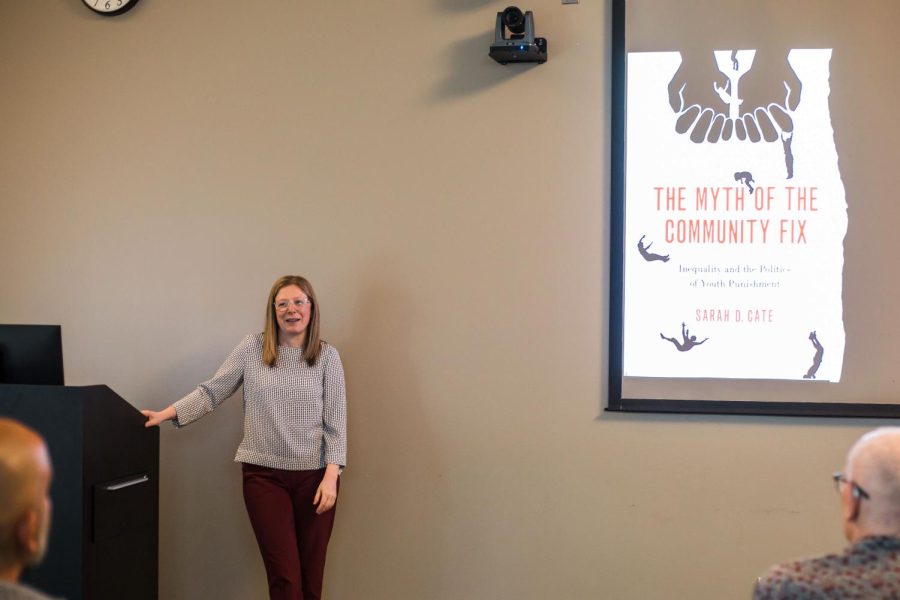How Can the U.S. Get Juvenile Justice Right? A Seattle U Professor Has Some Ideas.
Professor Sarah Cate at her book launch.
Associate Professor of Political Science Sarah Cate launched her first book, “The Myth of the Community Fix: Inequality and the Politics of Youth Punishment” to a group of colleagues and students May 5. The book incorporates Cate’s PhD dissertation to argue that recent reforms to the juvenile justice system still require improvement and should not be mirrored in the adult correctional system.
Cate’s interest in mass incarceration was piqued as an undergraduate student at the University of Oregon, which carried into her PhD program at the University of Pennsylvania. Reforms in the juvenile justice system in particular were receiving positive buzz at the time, and the emerging community-based model of corrections seemed like an interesting place to direct her research for her dissertation.
Community-based corrections operate off of the idea that larger state-run prisons are not the ideal form of detention for juvenile offenders. These environments are often far from the inmate’s home county, which can allow abuses to go unchecked. Such was the case in Texas, where investigations into sexual abuse scandals occurring in state prisons inspired lawmakers to pursue a community-based model.
Cate utilizes data from three states—California, Texas and Pennsylvania—in her research. States following the model, which was popularized in Pennsylvania, have closed down the state-operated juvenile detention centers in favor of county-level facilities.
“Then, the idea is to expand county-level programs through public-private partnerships. Build up a nonprofit structure to serve those kids who we previously would have sent to the state-run prison to try to help them and intervene at the local level,” Cate said.
What occurs after the switch to county-level detentions is incarceration on a smaller scale, according to Cate’s research. When she discovered this outcome, Cate redirected her research to evaluate the failings of community-based corrections. She argues that in many ways the county-level detentions prove equally as harmful to inmates because the counties operate with less intense scrutiny than state prisons.
Once juvenile offenders are relocated to the local level, counties are asked to handle them, generally with little directive or oversight. Counties are often awarded block grants, large sums of money to accommodate the sudden influx of new inmates. The counties that juvenile offenders return to are often poorly-funded to begin with, so the block grants are used to expand existing correctional facilities instead of investing in social services such as education.
Cate worked on the project for 10 years, and for the last six has been writing the book based off of the research in her dissertation. The May 5 book launch offered a condensed version of the background, key issues and potential solutions covered in the book.
Ruby Batch, second-year political science major, attended the book launch after hearing about it in Cate’s Social Movements university core (UCOR) class. Cate’s lecture identifies tension between incarceration within communities and systemic inequality, which resonated with Batch.
“One of my favorite points from the lecture is definitely the use of the word ‘community’ in prison reform because it highlights the ways that we’re trying to place blame on individuals within the system instead of working to fix systemic inequality,” Batch said.
Maya Walthall, first-year political science major, took Cate’s Mass Incarceration UCOR in a previous quarter and also attended the event. Because of the coursework, Walthall felt very familiar with the material but also learned about how nonprofit organizations, in addition to for-profit companies, have a lot to benefit from in the prison industrial complex.
“I thought the nonprofit portion was really interesting, where [Cate] talks about how nonprofits might be funded by different corporations and the differences between grassroots operations and top-down organizations,” Walthall said.
Cate makes the point that, while the majority of prisons are still publicly operated, correctional facilities will often cut contracts with food, medical and security providers that are privately-owned in order to keep the prison running. The privatization of the prison industry undermines the social power of the working class, which includes prison security personnel and the inmates themselves.
“What’s happening is just like education, just like the healthcare system, just like housing. In the name of reform, we’re taking something that’s in the public domain and we’re privatizing it,” Cate said. “The main thesis of the book is that criminal justice policy doesn’t occur in a vacuum and is developed in relation to major shifts in economic policy in the U.S., and the biggest ones are the destruction of public goods.”
Community-based solutions are not a cure-all to juvenile or adult correctional systems, according to Cate. They continue to grow in popularity, but as the negative effects become known through further research, Cate hopes that those in the political and criminal justice sectors look for solutions that invest in the social power of the working class.


